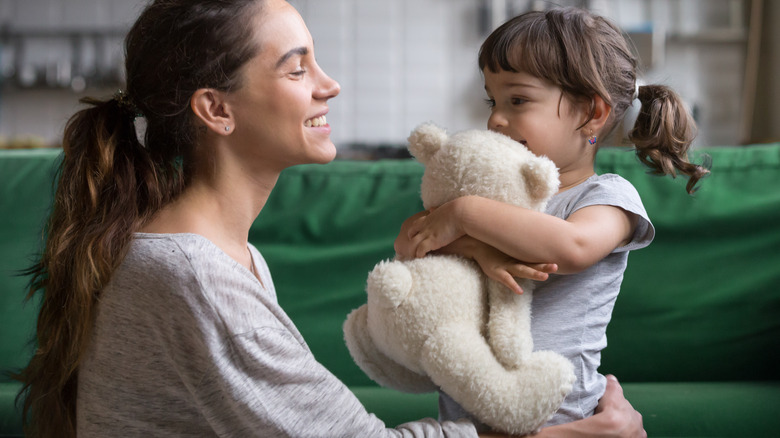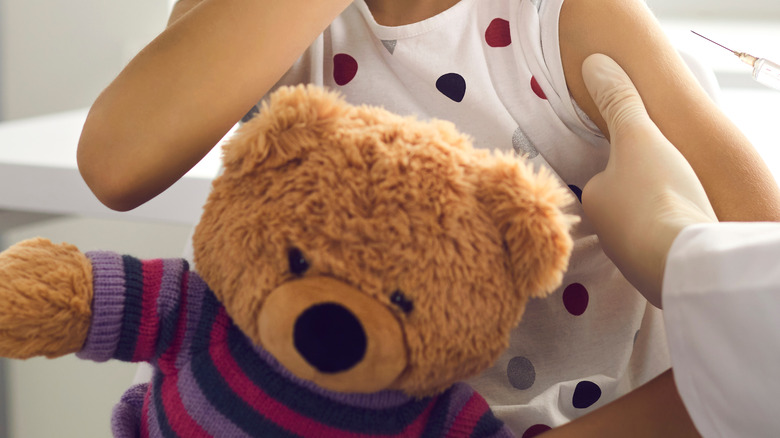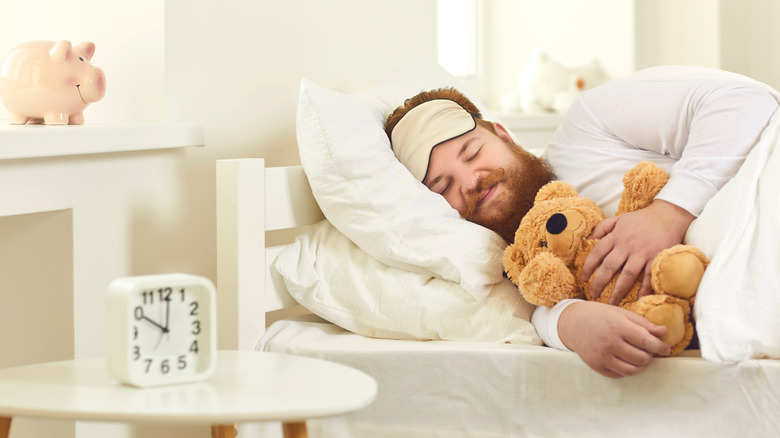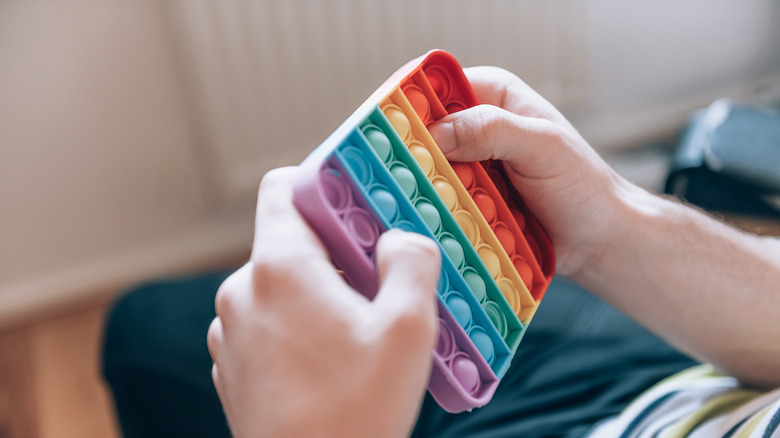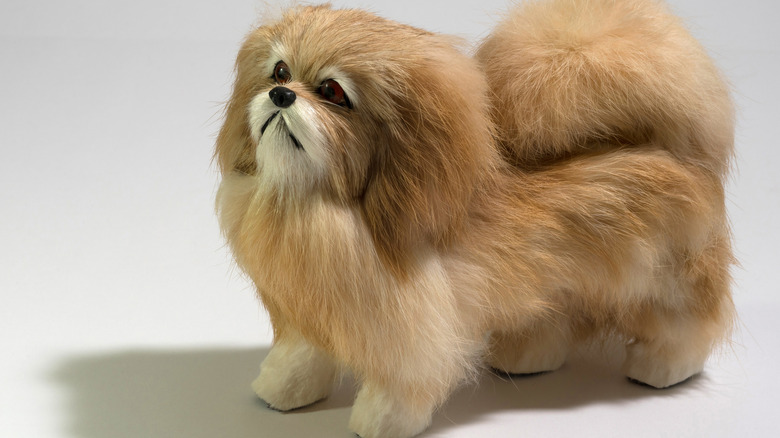Transitional Objects May Help With Grief Processing
Figuratively speaking, what comes to your mind when you hear the word "security blanket"? If you're a working single parent, you're probably thinking of your nanny. If you're an investor, gold and estates are probably your lifeline. If you're fast approaching retirement age — your retirement fund is your psychological reassurance. For those who are coping with grief, the answer might be much simpler — transitional objects.
Fundamentally, transitional objects are huggable items that bring comfort and reassurance to an emotionally struggling child, such as a fluffy teddy bear, a cozy and soft blanket, an old sweater frayed at the seams, or a memento that holds strong sentimental value, per BabySparks. These objects are usually used to soothe and help a child cope with an unfamiliar or traumatic circumstance, such as starting school, losing a loved one, or moving to a new country.
Most of the time, children stop relying on transitional objects for psychological support as they grow up and find themselves with more self-soothing options. Or, they think they've gotten too mature to need an imaginary friend. However, there are many adults who are still keeping their childhood comfort objects. Barbara Howard, a developmental-behavioral pediatrician at Johns Hopkins, tells The New York Times that approximately 25% of women carry a childhood transitional object to college with them. Nobody's too old to seek comfort from a steady presence in their life since childhood. If any, transitional objects can help adults cope with grief and learn to heal. Here's why.
Transitional objects help keep memory alive
The belongings of loved ones who die can also take on the role of transitional objects of grief. Keeping the memory of the deceased alive through the preservation of their possession isn't a new grief-alleviating technique. According to a 2021 study conducted by the University of York, the tradition of preserving an emotional attachment with the deceased by revisiting their possessions traces back to the Iron Age. Researcher Dr. Lindsey Büster explains: "My work uses archaeology to open up discussions around death, dying and bereavement in contemporary society, demonstrating that even the most mundane objects can take on special significance if they become tangible reminders of loved ones no longer physically with us."
The fact that we're living in the 21st century doesn't make this form of commemoration any less relevant. Attachment objects of grief, representing the familiarity and comfort reminiscient of the one who went away, can serve as a substitute for the actual attachment figure. The belongings of someone who departed their life can become a much-needed source of comfort for the ones who are left behind. That's the case of 44-year-old life coach Christina Wilson, who lost her best friend Teresa in 2015. Every year on Teresa's birthday, Wilson would spritz "Scandalous," a discontinued Victoria's Secret body spray that was her bestie's favorite. "It just makes me feel close to her and that she's really not that far away. It's comforting to access her memory that way," Wilson tells InStyle.
They help you sleep better
Grief and insomnia are closely linked. Researchers frequently use the Pittsburgh Sleep Quality Index (PSQI) questionnaire to assess sleep quality in studies of people who don't get enough sleep. According to a 2005 study published in the Journal of Traumatic Stress involving 105 individuals, people experiencing grief reportedly have a PSQI score of 9.44, which denotes overall poor sleep quality. Bereavement can lead to sleeping problems. And poor sleep can make grief worse. By the same token, a night of good sleep at consistent times can also help the bereaved better cope with grief, per Sleep Foundation.
For those struggling with the loss of a loved one, cuddling with childhood comfort objects or carrying the belongings of the deceased might help reduce instances of sleepless nights. Such is the case of 29-year-old Rachel Lieberman, who tells Refinery29 that her sleep companion is the blanket her grandma gave her when she was born. "My blanket helps me to fall asleep quicker," explains Lieberman. "It's comforting and has just become a habit over the years. If I try to sleep without it, it usually takes me longer to fall asleep and I just feel weird — it's hard to explain." Sam Sasso has a similar experience, as someone who developed an intimate bond with strips of silk in her formative years, she tells Refinery29 that she can't snatch forty winks without her silk piece under her pillow.
They can reduce anxiety
For people experiencing the loss of someone or something they love, anxiety is a common side effect, per Cruse Bereavement Support. Pangs of despair and fear of uncertainties are very much crushing and keen during grief processing, leaving you wondering if you'll ever get out of this pain and feeling anxious about what will befall next. Those experiencing anticipatory grief as a result of a terminal disease may also experience increased anxiety, especially when they've had to take on additional obligations following the person's death. This is where transitional objects come in.
In a 1993 study published in the journal Perceptual and Motor Skills, 105 toddlers who were separated from their main caregivers engaged in ritualistic touching behaviors with transitional objects of their choice at some point. The results showed that transitional objects could be helpful in alleviating anxiety in mildly stressful situations and making separation more tolerable.
An adult's transitional object isn't always the same as that of a child. Pets like dogs, cats, and other animals can act as transitional items for adults. Like stuffed animals or any tangible items that can be held close to one's heart, these fuzzy animals can be petted and cuddled. When anxiety flares, petting or caressing an animal can instantly reduce your stress levels and alleviate a sense of loneliness. Your transitional object can also be as small and portable as a squishy ball or a necklace, which you can interact with and feel grounded whenever you feel nervous.
They make a huggable token of remembrance
For those who are grieving over the loss of a pet, getting a plush toy copy of your deceased furry friend for a transitional object is a good way to cope. Not only is making a replica of your dead pet a beautiful way to keep your pet in remembrance and in your everyday life picture, but it also allows you to hug and kiss your animal buddy long after they're gone, according to Petsies. Looking at a picture collage of your dead pet can help you release some tense emotions, but it's nothing like cuddling up with and confiding in a stuffed animal that looks just like our old friend.
Psychologist Tsholofelo Jood tells News24: "Stuffed toys are psychologically important and were termed transitional objects by Dr. Donald Winnicott in 1953." When we touch or smell anything soft and comforting, like a stuffed animal, oxytocin, a hormone that produces warm and fuzzy feelings that bring down stress and anxiety, is released within the brain. Cuddling with a plush, human-like item also considerably lowers cortisol levels, a stress hormone that affects immune system responses and inhibits the digestive and reproductive systems. Keeping plush replicas of deceased pets helps the bereaved feel connected with their beloved companions, giving them a much-needed element of comfort when they feel lonely and isolated.
